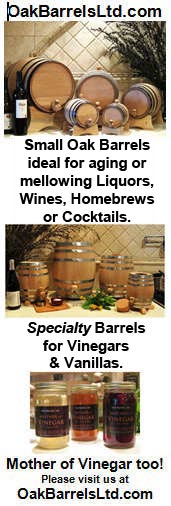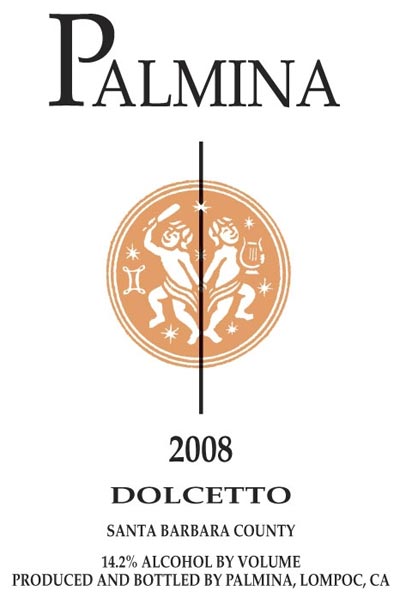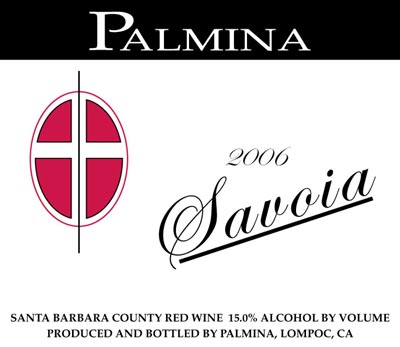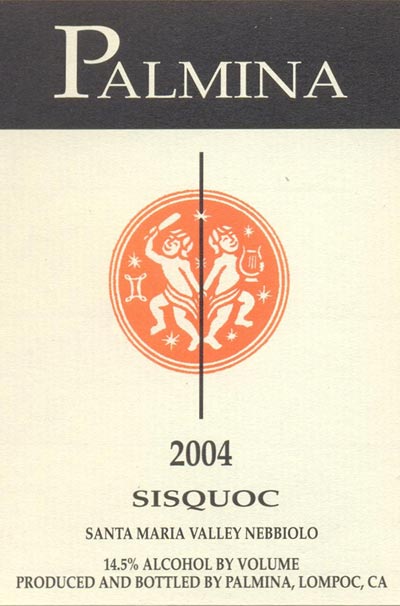Palmina—California’s Italian Variety Specialist
Wines based on Italian grape varieties have had a rough go of it here in California. What was supposed to be the next great thing in California wine is, today, a sideshow at best, and a rapidly dwindling one at that, as producer after producer quietly drops their Italian varietal wines in favor of more widely accepted (and profitable) varieties like Pinot Noir. And yet, just when it seemed Italian varietals had no future in California, a producer that makes nothing but Italian varietal wines (and blends made from Italian varieties) has emerged that finally makes a case for them. The winery is Palmina, and it has rapidly become California’s finest producer of wines from indigenous Italian grape varieties.
At first it seemed both simple and natural. French varietals like Cabernet and Chardonnay had established themselves brilliantly here, producing superb wines that reflected some of the same characteristics and greatness of their French counterparts, but with a uniquely California accent. In the minds of many Californians, the famous Paris tasting of 1976 “proved” that California wines were equal to, if not better than, the French wines made from the same varietals. Couldn’t the same be accomplished with the great Italian varieties like Nebbiolo and Sangiovese? After all, the warm California climate is more similar to Italy’s than to France’s. And weren’t many of California’s winemaking pioneers of Italian ancestry? Surely with a little work in the vineyards, aided by the technical superiority of California’s UC Davis-trained winemakers, California would be turning out their own versions of Barolo and Chianti that would compare favorably with, and even surpass, their Italian parentage.
Well, it didn’t quite turn out that way.
America’s first efforts focused on Sangiovese, and the results were less than enthralling. It seemed as if California’s winemakers wanted their Sangiovese’s to drink like mini-Cabernets—high levels of ripeness and extraction, tons of expensive new oak, and fancy bottles (and prices) were the characteristics of many of those efforts. The wine-buying public tried them, and promptly went back to their tried-and-try favorites like Cabernet and Pinot Noir. The problem is that Sangiovese (or just about any other Italian varietal for that matter), when made like Cabernet, loses all of the freshness, vivacity, and easy drinkability that is the hallmark of a varietal like Sangiovese. The resulting wines tasted more like mediocre Zinfandels, or, worse, generic “red table wines” of no particular character whatsoever. Today, with very, very few exceptions, domestic Sangiovese is a bore and is dead in the market. And the experience with Sangiovese pretty much killed any attempts to experiment with less well-known varieties like Tocai Friulano, Dolcetto or Barbera, much less a notoriously difficult variety like Nebbiolo.
But despite the “failure” of Italian varietals over the past 20, a few producers quietly continued to hone their skills and rediscover the qualities that make Italian varietals special, and figure out how to retain those qualities without simply creating a carbon copy of the original. Perhaps the most prominent Italian-focused winery in California is Palmina, in Santa Barbara County.
Palmina is owned by Steve Clifton and his wife Chrystal. Most people are more familiar with Steve’s other winery, Brewer-Clifton, a partnership with Greg Brewer that focuses on the Burgundian varieties Pinot Noir and Chardonnay. Clifton began Palmina in 1995. I had vaguely been aware of the winery for some time, had generally enjoyed the bottle or two that I had happened to sample over the years, but the winery really didn’t register on my personal wine radar, as generally I do not follow or purchase Italian wines, and was not especially interested in Italian varietals in California. But recently I had the opportunity to taste through a significant range of Palmina’s wines, and I was frankly stunned at how good they were. Not just good, but true. Somehow Palmina has managed to make wines from grapes grown in Santa Barbara County that hew more closely to the Italian ideal—in terms of flavor, texture and weight of the wines—than any other winery in California that I’ve experienced.
The following represents only a small number of wines in Palmina’s portfolio. They seem to have both a “regular” and an upper level or single vineyard bottling (sometimes several) of most varietals, as well as a number of blends.
2008 Malvasia Bianca, Larner Vineyard, Santa Ynez Valley, $26.99. From the highly-regarded Larner Vineyard, better known for its Syrahs. Highly aromatic, with a tremendous mélange of exotic floral scents and crisp, intense minerality, with hints of citrus oil and incense, the wine is impeccably balanced and full of verve and energy. The acidity is particularly impressive, especially for an acid freak like me. Made in stainless steel barrels, the wine is only 12.5% alcohol. The structure makes it hard to believe this is a California wine. Find this wine
2008 Palmina Tocai Friulano, Honea Vineyard, Santa Ynez Valley,$19.99. After the bracing zest of Palmina’s Malvasia, this Tocai Friulano is much softer and richer without quite the energy of the Malvasia. Yet there is adequate acidity and minerality that gives structure to this round and smooth effort, with hints of apricot, citrus flowers and savory herbs that reminds me of a richer Pinot Grigio. Fairly weighty, but not ponderous or flabby. Nice sipping wine. Find this wine
2007 Palmina Barbera, Santa Barbara County, $20.99. The hallmark of Barbera is its bright acidity, which is combined with pomegranate and red plum and cherry fruit flavors to create a wine that goes wonderfully with Southern Italian food or anything with tomatoes or savory herbs like oregano. Most domestic Barbera’s are too heavy and zinfandel-like, but this one is true to Barbera’s heritage in Italy’s Piedmont region without trying to be a carbon copy. Although the wine is fairly ripe, it retains crisp acidity that is perfectly balanced by ripe fruit and a nice savory note. The texture is smooth but not heavy or thick, and the overall balance is excellent. Find this wine
2008 Palmina Dolcetto, Santa Barbara County, $17.99. The name “Dolcetto” translates to “little sweet one”, not because the wine made from Dolcetto grapes is sweet (it’s bone dry), but because it’s personality is so fresh, full of fruit, and friendly. I really liked this crisp, bright wine because it is so jam-packed with crisp, crunch fruits reminiscent of cranberries, black raspberries and little ripe strawberries. The texture is crisp and bracing with smooth tannins and minerality that beautifully frame the fruit. Flat-out delicious stuff, and at least as good if not better than most Italian Dolcetti I’ve experienced. Really good. Find this wine
2006 “Undici”, Santa Ynez Valley, $34.99. “Undici” is the name of Palmina’s upper-level Sangiovese, made from two clones, Sangiovese “Grosso”, and Sangiovese “Piccolo”, mainly grown at Honea Vineyard. This tastes much riper than the previous wines (15.3% alcohol), and it suffers by comparison. Blackberry jam with flavors of raisins and some roasted notes, rather heavy in texture and with moderate-to-low acidity. This lacks freshness as well as the vivacity that I enjoy in a good Sangiovese-based wine. A bit clumsy and without any distinct varietal character. In other words, more typical of a Sangiovese from a lesser producer from some hot weather terroir like Paso. Disappointing. Find this wine
2006 “Savoia”, Santa Barbara County, $47.99. An interesting (and distinctly non-traditional) blend of 50% Nebbiolo, 25% Barbera, and 25% Syrah. The nice aspect of this blend is that you can actually taste the varieties used, each really does add a bit of its own character to the wine—roses from Nebbiolo, tart cherries (and strong acidity) from Barbera, and floral and roasted notes from the Syrah. That said, I’m not sure the blend has really come together yet, as each variety kind of pokes its character out without really coming together into something harmonious. It’s also pretty ripe (15%), which thickens the texture and gives the wine a bit of a heavy-handed feel despite the strong acid profile, almost like an Australian shiraz (in structure, not flavors) but with better balance. Still, this is interesting and may come together with another year or two of maturity. Find this wine
2005 Palmina Nebbiolo, Santa Barbara County, $25.99 Most domestic Nebbioli that I’ve tasted are either innocuous wines taste nothing like the variety does in Italy, or huge wines that are overripe and thick with extract, as if “size” is the defining characteristic of Barolo. This wine, by contrast, has varietally correct flavors and texture, which emphasizes intensity of flavor rather than richness or weight. The wine has all the spicy and complex flavors usually associated with Nebbiolo—dusty rose petal, sour cherry, black tea and spice—with a medium body and plenty of smooth tannins that are the hallmark of Nebbiolo. Although this is made to be enjoyed in its youth, the balance and structure of the wine suggest that a couple of years of aging would be beneficial. Find this wine
2004 Palmina “Sisquoc”, Rancho Sisquoc Vineyard, Santa Maria Valley $45.99. “Sisquoc” is the proprietary name for Palmina’s top-of-the-line Nebbiolo. Quite simply, this is the most typical and well-made domestic Nebbiolo I’ve ever tasted. Possessing the classic “tar and roses” nose of the classic Nebbioli of Italy’s Piedmont, this remarkably complex wine offers flavors reminiscent of truffles, game, richly tanned leather and roasted nuts, along with hints of orange zest, caramel and rich earth. Much more complex than the basic Santa Barbara County bottling, there is enough maturity in this nearly 6 year old wine to see the secondary notes of earth and herbs, and the complex fragrance that makes Nebbiolo the “Burgundy of Italy.” The tannins are fine, certainly present (as they should be in a Nebbiolo), but not intrusive or green. This would probably benefit by being decanted to allow its remarkable fragrance to develop. Quite remarkable for a domestic Nebbiolo. Find this wine









Jason–
I guess my attitude toward Italian wines was formed when I was really first getting into wines in ’70′s and ’80′s. Back then, it seemed a lot of Italian wines had flaws of one sort or another, especially the whites, which could be really earthy and oxydized. I know things have changed dramatically, and I do enjoy Italian wines of both colors, but in terms of my own cellaring, I simply like too many other types of wines more. But I don’t disagree with you regarding the current quality of Italian wines, and I do enjoy them when I have occasion to drink them.
Thanks for the comment!
I am a little suprised you don’t drink much Italian wine.. especially the whites if you like crisp acidity and Sangiovese for that matter.. and Corvina.. I mean these are all wonderful wines. Drink some Italian wine. And yes Palmina are fantastic Ital cals. I wish more folks were staying with the Cal-Ital long enough to make it work.
Actually, I was more of an Airplane fan, back in the day. Same drug of choice, I suppose.
Dude, you’re an acid freak?! Are you into the Dead, man?
Just kidding…
Nice report, Bennett! Add these to the list of things I must try next time I’m out your way…